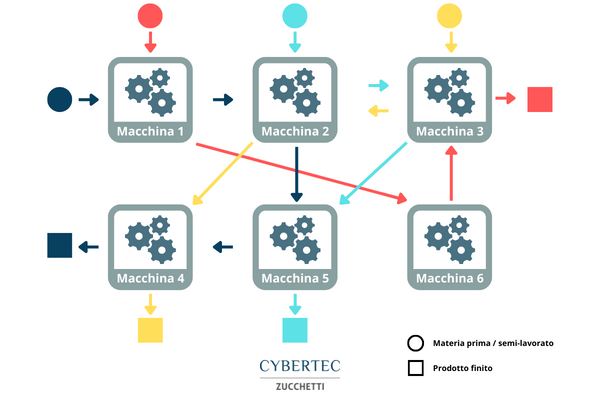While companies that produce a high variety of products, as in the case of Job Shop production, benefit from greater flexibility and elasticity in production, achieving good levels in the management of the peculiarities of such production requires the use of advanced tools to schedule and plan production in detail.
Whatis Job Shop production?
The production takes place on order and concerns small batches of more or less customized products at the request of customers according to specific needs. The finished product is therefore usually characterized by a certain degree of customization and low volumes. Examples of this type of production concern special machinery, equipment or components made to design, engineering works or shipbuilding.
The need to customise products and produce batches that are different from each other entails having to redefine the production cycle every time and at the same time makes it difficult to establish the required processes in advance and in what sequence. For this reason, standard machinery with generic capabilities are used, which are set each time with the necessary parameters to carry out the different types of processing required.
Production begins only after receiving the order from the customer, agreeing on the specific characteristics and analysing their feasibility. Each order to be completed requires a precise sequence of operations in the work centres established by the work cycle. The production cycle is then unpacked into individual operations, each carried out in a department by ad hoc machinery.
While Job Shop production is characterised by the almost total lack of stocks of finished products, on the other hand, the stocks of processed seeds that accumulate between the various stages of the production process are rather substantial, requiring special attention in their management. In fact, during production the batches of processed seeds move between the various departments with intertwined and twisted paths that differ from order to order. Depending on the manufacturing requirements of the product, batches and could even return to the same machining center multiple times.
For this reason, the correct functioning of Job Shop production depends to a very great extent on the decisions that are made on the alternations between production cycles and the criteria chosen to make batches exceed the waiting lines. With the right choices you can positively influence factors such as the economy of production, the level of saturation of the machines, the duration of the average crossing time, the size of the WIP.
The advantages of Job Shop production
The main advantages of Job Shop production concern:
- Product engineering and design customization: possibility for customers to get involved and participate in the order customization process.
- Easily adaptable to change: possibility to change the organization or size of the plant. Machines can be easily added or replaced to adapt to changes in the process, without requiring a complete reconfiguration of the entire company layout.
- Better use of resources: resources can be used efficiently for order fulfillment by being able to dedicate highly qualified workers to the production phase. The organisation in departments also promotes interchangeability and the exchange of skills between operators, as well as the possibility of supervising multiple machines with a single operator.
- Flexibility: the possibility of prioritizing certain operations thanks to the irregular flow of work.
- Product monitoring: it is easy to follow the progress status of products by checking their passage through the individual processes.
- Less investment: limited to the purchase of standard machinery that is equipped for specific operations. Moreover, since they are multipurpose machines, they suffer less obsolescence.

The Disadvantages of Job Shop Production
Turning instead to the disadvantages, the main ones concern the difficulty in scheduling production due to the high variability of the product and the twisted production flow. In addition, Job Shop production requires space for the planimetric set-up of the departments with the various machines.
Going into more detail about the negative aspects of Job Shop production:
- Scheduling production can be complicated: the order flow can follow an inconsistent pattern, facilitating the occurrence of backlogs. Situations can therefore easily occur where a few orders are received one day and a full load the next day. This makes it necessary to be able to change the schedule responsively to complete orders and satisfy customers.
- Difficult organization: the flows related to the advancement of materials are articulated and interference can be generated between the production cycles of the various orders. In addition, the difficulty increases depending on how complex and complex the products are. This has repercussions on management and scheduling difficulties in the use of resources.
- Determining production capacity can be complex. We must start from the productive potential of each work centre, but it can be difficult to estimate it due to the continuous variability of the products. Additional influences come from the mix of outstanding orders and other variables, such as batch size, re-equipment hours for production changes, product complexity.
- High material handling cost: due to transport, storage and damage of finished goods and processed seeds. Also, moving goods between departments comes at a cost but adds no value.
- High or low workload: a non-optimal level is in both cases a disadvantage. If you receive a large number of orders you face an intense workload, in the case of low or no orders, the resources are not fully exploited.
An example of Job Shop production
Let’s take a closer look at Job Shop production, considering a company that produces customised eyewear as an example. The production cycle is divided into five phases, each characterised by specific processes.
Design. Starting from a range of stock frames, the customer can choose the preferred design and customize it by choosing the material. Then the customer’s measurements are taken and production can begin.
Preparation of materials and cutting. Once the order is registered, the necessary raw materials are taken from the warehouse and the cutting of the materials can begin in accordance with the requirements of the customer’s order. The activities will each be carried out in a specific department.
Shaping. Once the materials have been cut and prepared, the shaping process begins, which serves to give the desired shape to the material.
Painting. Once the frame is ready, the product is subjected to painting. The process can take several days and involves multiple coats of paint.
Software to improve Job Shop production
As seen, Job Shop production allows to obtain considerable advantages in terms of flexibility and optimal use of resources, however it brings with it management pitfalls that, if not treated correctly, risk creating considerable delays in the execution of orders with the danger of having dissatisfied customers.
That is why, in addition to elasticity in production, it is important to have advanced tools to schedule production.
CyberPlan APS is the scheduler to plan the production with a very high level of detail on the machines, creating optimal processing sequences on the individual machines and monitoring the factory closely. You can achieve maximum saturation of plants, personnel and resources without compromising delivery dates and respecting priorities and constraints.
